
A shoe is an item of footwear intended to protect and comfort the human foot. Though the human foot can adapt to varied terrains and climate conditions, it is vulnerable, and shoes provide protection. Form was originally tied to function but over time shoes also became fashion items. Some shoes are worn as safety equipment, such as steel-toe boots, which are required footwear at industrial worksites.

Footwear refers to garments worn on the feet, which typically serve the purpose of protection against adversities of the environment such as wear from rough ground; stability on slippery ground; and temperature.

Tabi are traditional Japanese socks worn with thonged footwear such as zori, dating back to the 15th century.

Clogs are a type of footwear made in part or completely from wood. Used in many parts of the world, their forms can vary by culture, but often remained unchanged for centuries within a culture.

Flip-flops are a type of light sandal-like shoe, typically worn as a form of casual footwear. They consist of a flat sole held loosely on the foot by a Y-shaped strap known as a toe thong that passes between the first and second toes and around both sides of the foot. This style of footwear has been worn by people of many cultures throughout the world, originating as early as the ancient Egyptians in 1500 BC. In the United States the modern flip-flop may have had its design taken from the traditional Japanese zōri, after World War II as soldiers brought them back from Japan.

Sandals are an open type of shoe, consisting of a sole held to the wearer's foot by straps going over the instep and around the ankle. Sandals can also have a heel. While the distinction between sandals and other types of footwear can sometimes be blurry, the common understanding is that a sandal leaves all or most of the foot exposed. People may choose to wear sandals for several reasons, among them comfort in warm weather, economy, and as a fashion choice. Usually, people wear sandals in warmer climates or during warmer parts of the year in order to keep their feet cool and dry. The risk of developing athlete's foot is lower than with enclosed shoes, and the wearing of sandals may be part of the treatment regimen for such an infection.

Hiking (walking) boots are footwear specifically designed for protecting the feet and ankles during outdoor walking activities such as hiking. They are one of the most important items of hiking gear, since their quality and durability can determine a hiker's ability to walk long distances without injury. Hiking boots are constructed to provide comfort for walking considerable distance over rough terrain. Boots that protect the hiker's feet and heel are recommended. Hiking boots give ankle support and are fairly stiff. A less popular alternative is to use light trainers with thin soles. Footwear should be neither too loose nor too tight, to help prevent blisters and sore feet. Hiking socks that wick sweat from the feet, provide warmth, and cushion the feet are recommended and a thin, inner sock may also help. Most hiking boots are also designed for other outdoor activities such as backpacking, climbing, mountaineering, and hunting.
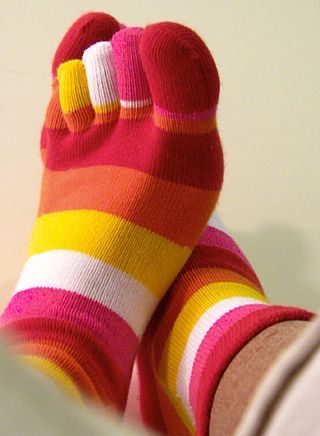
Toe socks are socks that have been knitted so that each toe is individually encased the same way as fingers within a glove.
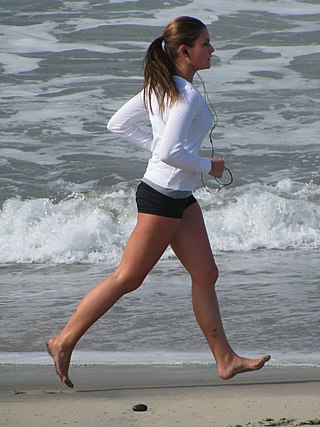
Barefoot running, also called "natural running", is the act of running without footwear. With the advent of modern footwear, running barefoot has become less common in most parts of the world but is still practiced in parts of Africa and Latin America. In some Western countries, barefoot running has grown in popularity due to perceived health benefits.
Merrell is an American manufacturing company of footwear products. It was founded by Clark Matis, Randy Merrell, and John Schweizer in 1981 as a maker of high-performance hiking boots. Since 1997, the company has been a wholly owned subsidiary of Wolverine World Wide. Products currently commercialized by Merrell include hiking boots, athletic shoes, sandals, jackets, knit caps, gloves, t-shirts, hoodies, shorts, and socks. Other accessories include backpacks, stuff sacks, and bags.
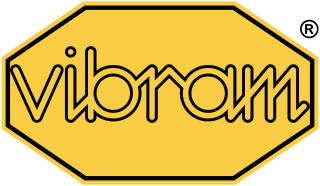
Vibram S.p.A. is an Italian company based in Albizzate, Italy, that both manufactures and licenses the production of Vibram-branded rubber outsoles for footwear. The company is named after its founder, Vitale Bramani, who is credited with inventing the first rubber lug soles. Vibram soles were first used on mountaineering boots, replacing leather soles fitted with hobnails or steel cleats which were commonly used up until then. The soles produced by Vibram are called Vibram soles, Vibram rubber or simply Vibram.
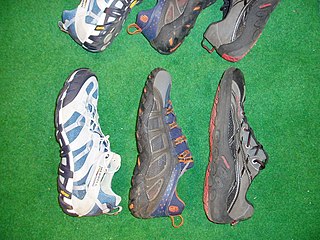
A water shoe is a type of footwear that is typically used for activities where the feet are likely to become wet, such as kayaking. Water shoes are usually made of mesh and have a hard sole used to prevent cuts and abrasions when walking in wet, rocky environments. They may often have tiny holes on the bottom or sides of the sole to allow for quick water drainage, which helps the wearer's feet dry faster, keeps the shoe light, and prolongs the lifespan of the material. Additionally, most people do not wear socks with water shoes.
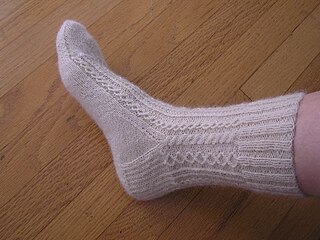
A sock is a piece of clothing worn on the feet and often covering the ankle or some part of the calf. Some types of shoes or boots are typically worn over socks. In ancient times, socks were made from leather or matted animal hair. In the late 16th century, machine-knit socks were first produced. Until the 1800s, both hand-made and machine-knit socks were manufactured, with the latter technique becoming more common in the 19th century, and continuing until the modern day.

The Vibram FiveFingers are a type of minimalist shoe manufactured by Vibram, originally marketed as a more natural alternative for outdoor activities. The footwear is meant to replicate being barefoot and has thin, flexible soles that are contoured to the shape of the human foot, including visible individual sections for the toes. The company settled a lawsuit in 2014 alleging false health claims and set aside $3.75 million to pay refunds of up to $94 to anyone who had purchased the product since March 21, 2009.

Huaraches are an open type of outdoor footwear, consisting of a sole held to the wearer's foot by straps passing over the instep and around the ankle. The common understanding is that these sandals were a variant of traditional Mexican huaraches, the difference being in design and construction.
Altra Running, commonly known as Altra, is an American manufacturing company engaged in the design, development, marketing, and sales of athletic shoes for road running, trail running, and general footwear. Since 2018 Altra is owned by VF Corporation, an American global apparel and footwear company with other brands like Icebreaker, The North Face, Vans, JanSport, Eastpak and Timberland.

Minimalist shoes are shoes intended to closely approximate barefoot running or walking conditions in comparison to traditional shoes. Minimalist shoes are defined as providing "minimal interference with the natural movement of the foot, because of its high flexibility, low heel to toe drop, weight and stack height, and the absence of motion control and stability devices." Minimalist shoes provide more sensory contact for the foot on the ground while simultaneously providing the feet with some protection from ground hazards and conditions. Research shows that wearing a minimalist shoe can help improve running economy, foot strength and arch function.
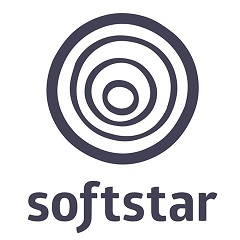
Softstar Shoes is an American shoe manufacturer and retailer based in Philomath, Oregon. It is known for its minimalist or barefoot-style shoes and has been recognized as an early participant in the movement to encourage minimalist footwear.

Barefoot is the state of not wearing any footwear.
















